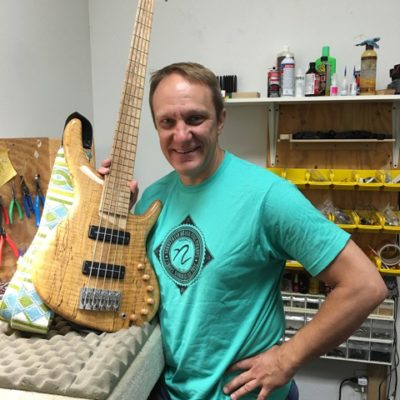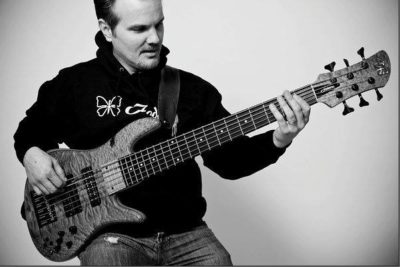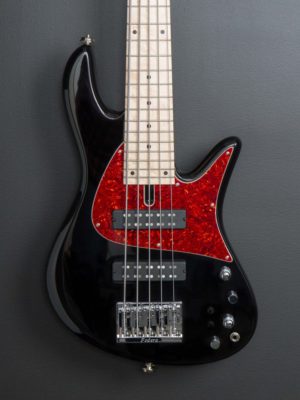The Ultimate Studio Bass Buyer’s Guide: Great Bassists on Choosing the Best Instrument for the Recording Studio

It’s a good time to be a bassist. Even boutique classics like the Hofner Club Bass and Music Man Sterling—once reserved only for those with expensive tastes—are now available at a surprisingly high level of quality at nearly every price point.
New technology for making guitars and basses has turned the luthier’s job into as much of a science as an art form.
Thanks to the advent of advanced “CNC machines” that now aid major guitar makers in some of their most difficult and time-consuming tasks, the fretted instrument market has been undergoing the very same radical transformation we have seen in microphones, preamps, interfaces and the like in recent years: Prices are going down while quality is going up.
So, with the customary gap between high-end basses and affordable basses narrowing every year, what still separates a great studio instrument from a mediocre one?
I asked a few amazing players and well-respected instrument designers for their take and, then put together a list of some of the best studio bass options on the market today, whether you have a tiny budget or huge one to play with. First, a few of my own thoughts:
Know What You’re Paying For: What Makes a Good Bass Great?
As a bass player myself, I’ve come to find that three main attributes help distinguish a good bass from a great one.
Assuming that the electronics are of good quality and properly installed, the most important feature for me has always been playability, which comes first and foremost from having well-built and comfortable neck. This includes fret dressing, which is possibly the most important features here.
There is almost nothing worse for a player than the feeling of scraping your fingers against frets that are protruding from the edges of a fingerboard. Fortunately, many lower-end manufacturers are finally taking care of this long-standing problem thanks to a CNC device know as the “Plek” machine, a “computer-controlled device that scans and dresses guitars under actual playing conditions, strung and tuned to pitch.”
Good fret dressings can now be found on even the cheapest of instruments today. However, with some lower-end brands you still might have to play a few of them to find one that’s really perfect. Along with that low price tag comes the reality that they’re outsourcing a little bit of their quality control to you, the end buyer.
Another one of the other most essential traits of any great studio instrument is stability. A great studio bass needs less tuning, fewer adjustments to the neck, intonation and action, and will sport electronics that are well-built and dependable enough to never break down mid-session. Once again, even the least expensive instruments are doing better on this front than they ever have in the past.
Tone is obviously a huge component of a great electric bass as well, and when it comes to tone, knowing your own subjective tastes is just as important as anything. Equally important of course, is an ability to make the instrument sound great through your own playing! This is a power that lies in the hands of the player.
Here are the thoughts of three of my favorite bass players and designers on bass selection, followed by a massive roundup of some of the best studio bass options available for any budget.
Carey Nordstrand
Carey Nordstrand founded Nordstrand Guitars in 2002 and debuted his successful line of bass pickups and preamps in 2003.
Nordstrand has managed to become a major name within the bass-playing community, and his instruments can be found all over the world, often on the largest stages.
Carey’s electronics can also be found in basses from a wide range of manufacturers, from big brands like Ibanez, to a whole slew of custom and boutique builders.
In addition to his bass-making business, Nordstrand has a passion for making recordings in his impressive home studio, and produces new releases there on a regular “basis”.
Carey, what is the “ideal” electric bass for recording to you?
The ideal bass for recording will always depend heavily—and I could even say totally—on what style of music and production is being tackled.
I’ve personally got a couple P-style basses: One Nordy vP5, a refinished 63 Fender P-Bass with my pickup in it. I have one four-string [Jazz Bass], one five string modern J-ish bass (my own “NJ5” model) and a five-string Nordy Slim vJ5 with a BigMan and a BigSplit pickup for a Music Man kinda vibe, and an old Ibanez Musician fretless bass with my pickups in it.
Each one of these will be selected depending on where the music is going and what the instrumentation is like. As a matter of fact, the selection of the bass and the rest of the instruments is really co-dependent and inseparable.
In other words, how the guitars and drums are starting to sound will inspire me to try a certain bass, and how the bass sounds will in turn inspire me to try different guitars and/or keys. It can go back and forth like that a lot for each tune, and it can evolve to where the original bass selected no longer sounds “right” for the tune.
So, I guess the short answer to your question is that the “ideal” bass is a very fluid thing and most certainly not contained in one actual instrument. This is why we players have a “collection” of instruments, and it’s also why producers tend to have a LOT of basses, guitars, amps, and other recording gear. You never know where the music will take you and sometimes finding the right sound can make or break a track.
Are there any “ideal” attributes that you feel are important in a bass that is used for recording?
Again, this is a very dependent thing musically. That said, there are certainly some objective things that can be mentioned beyond the sound: First, you need it to be technically capable of the part that’s being played. A P-bass with high action will probably not work right for a fast fluid solo in a jazz tune and a low action modern instrument won’t feel—or sound—right when it comes to pounding out a thumpy vintage heavy rock line.
Second, you probably want a bass to be fairly quiet in terms of electronic noise so you get a nice clean track. Third, you want the bass to play in tune. Fourth, you want to bass to inspire the player to create a killer part. This means the bass should sound great primarily, but it should also look inviting and engaging, and feel great.
If there is no one bass that handles every genre or style perfectly, do you have any general categories or attributes that help you narrow down the choice for a given track?
Well, I think in terms of sonics you can define things in terms of frequency response: Bass, mids, treble and how much of each of those a bass has. Also, sustain: Less or more, even to the point of using a mute or an ebow. Clarity is another quality that you can judge: Muddy or not.
My favorite attribute though, is not one that’s quantifiable in any scientific way, and it supersedes all the above: character
This is a largely intangible thing that I usually notice when I realize I can’t stop playing and exploring what an instrument can do sonically. It’s an inherent and intrinsically emotional appeal. It’s the holy grail that I’m after as a builder and a pickup maker, and also as someone who is creating in a studio regularly.
Unfortunately, it’s often fairly elusive. That’s why I recommend trying many instruments before you buy, at least if you have a chance, and then when you find one that speaks to you, don’t ever let go of it.
Are there any studio tricks for recording bass that you like?
I guess I don’t really have any studio tricks for recording bass. I just go direct into an Apollo Quad interface with a Neve 1073 Unison preamp. I do have an old flip top Ampeg that I’m going to start playing around with mic’ing though. Should be fun. I should also mention that I really like the UAD dbx 160 plug for compression, but I find you really need to get the threshold set just right. One more thing—and this might be a little bold—but I really try to get bass tracks that need zero EQ.
99% percent of the time I get away with that by picking the right bass for the music. And I would say that that’s one of the reasons Fender and Fender style basses are so beloved by rock and pop music engineers around the world. They see one and they know they aren’t going to have to work hard to get a good bass sound that fits in the track just right.
If you had to pick just one bass from your arsenal to use forever, which one would it be and why?
It’s impossible to cut down to just one. But if you put a gun to my head, I’d probably pick the NJ5 I made for myself 12 years ago. It’s become “that bass” that just feels like a part of me. And with a handful of my different pickups, I could get almost any sound I want from it.
How about amplifiers? Do you have a favorite one there?
I’m really limited in my experience of amps. I tend to find something that works and then stick with it. I used to use an Aguilar DB750 and a couple GS112’s. But I find I’m getting great results from a new Genzler Magellan 800 amp and his 1×12 BassArray cabs. Great stuff and nice and light. In the vintage realm an SVT through an 8×10 is always awesome.
Mike Pope
If you do not know Mike Pope, you need to do yourself a favor and look him up: Pope has been sharing the stage with some of the top jazz musicians in the world, including Chick Corea, David Sanborn, Al DiMeola and Bill Bruford.
Not only is he highly sought after for his playing ability, he is also an accomplished bass preamplifier designer. His preamps (in one form or another) come standard on both the Fodera bass line, with the exception of Monarch P.
He also has his hands in designing bass amplifier: Trickfish Amplifiers is a collaboration with two other bassist “working together on the electrical engineering, system design and user interface of the TF Gen 1 heads.”
Mike’s rack mount pre-amps have been heralded by bassists worldwide for their “purity, simplicity and sheer musicality”. Mike is active as a recording bassist and is currently building a home studio.
What makes for an “ideal” electric bass for the recording studio?
As a bass player, idiomatic demands sometimes take precedent. In terms of an instrument that lets me be me, neutrality goes a long way. But when a song demands a Marcus thing, I want a 70’s J bass, or a Music Man if it’s a Louis Johnson or Paul Jackson thing. To my thinking, there’s no substitute for a “period” instrument, so to speak. When it’s my choice entirely, there are not many results that I can’t get out of my Fodera Viceroy.
If there is no such thing as one bass that handles every genre or style perfectly, do you have any categories or attributes that help narrow down the choice for a given session?
To me there’s a P-bass sound, a 70s [Jazz Bass] sound, a 60’s J-Bass sound, a Music Man sound, a thuddy 60s-rock Gibson bass kind of sound, a Rickenbacher rock sound (á la Geddy Lee/Chris Squire) and a “Beatles bass” sound—to put it in fairly broad terms.
Are there any studio tricks that you like to employ?
For bass, not really. Get the source right and less is more.
How about build philosophy? Tone woods or production processes?
I like mahogany because it’s pretty neutral, as well as ash, alder for their well known characteristics, and koa for its particular midrange thing. I’ve heard walnut basses I’ve liked, too. In terms of production process, I like how Fodera does it, and am not sure what I can divulge.
What’s your favorite studio bass and why?
My Fodera Viceroy because of its enormous flexibility and incredible playability.
Your Favorite amplifier?
The Trickfish amps with the Trickfish speakers represent the current destination for me. The front end is essentially my old MPP-1 preamp design that has been highly refined and integrated into a 1000 watt, 6 lb package by David Yates.
The speakers were designed by Anthony Fregoso and Richard Ruse and represent the best balanced speakers I’ve ever heard. Never have I played through a speaker that could deliver the warm and punchy finger sound they do, while still having enough high frequency content to jump way out when slapping but never ever sound harsh or “clacky” with fingers. It’s kind of paradoxical. I don’t know how they managed it.
Do you have any favorite outboard gear for recording bass?
I don’t have any, really. I can get a great sound with my SP737, AD2022, ISA428, RME stock preamps…whatever I use works fine for me. The differences generally aren’t really important to me.
Charlie Chadwick
Charlie has been a staple in the Nashville music scene for over twenty years and is an active performer, studio musician and studio owner in the area.
When he is not on the road, you can find Chadwick playing and recording with some of Nashville’s best. Due to the rigors and complexities of traveling world wide, he has design the “Folding Bass” which has become a hit with upright players that travel.
Charlie has been an inspiration to me. When I attended Middle Tennessee State University as an undergraduate I had several opportunities to hear him play and pick his brain about being a musician. In the last twenty years I have managed to stay in touch with him and still continue to learn from him.
What makes for an “ideal” electric bass for the recording studio?
I believe that, by far, the most important piece of gear is the bass player. Mental attitude, awareness of your surroundings, and preparation. I heard that a fan once came up to Chet Atkins, telling him his guitar sounded great that night. Chet looked over at it sitting in the stand and said, “how does it sound now?”
My choice of bass is determined by the song, the instrumentation, and the bass part I’m playing. Unless I’m making a solo bass record, the most effective bass will be the one that sits best with the other sounds in the track. I keep in mind that my tonality is only a part of the overall frequency spectrum, and rhythmically, I’m only a part of the feel. The “right” bass is the one that best juxtaposes the other sounds, and propels the track.
My favorite studio trick is to help keep the mood light and playful. The studio can be a very uncomfortable place to make music, and bringing a relaxed attitude helps everyone stay focused on the music.
Real World Options
Now to the really fun part! If you have not yet read SonicScoop editor Justin Colletti’s 2014 article on the best electric basses for the recording studio—read it now! This story covers the fundamentals of bass types, outlining most of the “major food groups” of the studio bass world and where they excel: The P-Bass, the Jazz Bass, the Music Man, the violin bass and the EB-0.
I wanted to dive into more detail, identifying specific instruments and manufacturers in each of the categories that he established, so here goes.
Economy Route:

A Music Man “S.U.B.” Model is one of the more cost-effective options for a punchy and versatile studio bass.
Squier Vintage Modified Series
These basses range in cost from $199 to about $399. They can be had with the traditional single split coil P-style pickup or with the option of having a jazz pickup added to the bridge position.
Fender Standard Series
For a couple more bills you can buy into the Fender name and have a great playing. These basses are made in Mexico and their manufacturing techniques have come a long way in the past twenty years. Around $599.
Music Man S.U.B.
If you are a fan of the Music Man’s crisp top end and beefy lows Music Man’s entry-level S.U.B. Line offers a low-cost version of the Sterling starting at just $299.
G&L JB2 and SB2
Lets not forget Leo Fender’s last instrument designs were in the G&L company. If you can swing the extra money the G&L JB2 and SB2, these are excellent basses at the upper end of the “economy” level at around $450.
Hofner
Hofner makes both the violin and club style “Beatle” basses in their affordable “Ignition” series. Prices range from $350 to $470 with case.
I briefly owned the Cavern bass and regret selling it. I found that putting good strings (in my case Labella “Beatles” flatwounds) really gave the bass weighted and deep blossoming tones. Great for R&B, Reggae and anything “old school” sounding in nature.
Working Class Route
I call this the working class route because at these price points the quality and stability of these basses are rather impressive. Their appointments can rival high end basses.
Fender
The Fender Classic 50’s and “Road Worn” series are under $1000. They feel great and sound fantastic. Made in Mexico. The Fender American Standard instruments are priced around $1350-$1400 and you should expect stability, great playability out of these basses.
A good Fender is kind of like the macaroni and cheese with bacon of the bass world. This is comfort food for the ears. We are familiar with their sounds and associate so many feelings when listening to the thuddy and fat split coil-designed pickup of the Precision Bass or the “laid back and refined”, more open and clear single-coil pickups of the Jazz Bass.
Music Man
In a very affordable Korean rendition of the classic Stingray, the “Ray34CA”, is not far off from the American versions of the Stingray for less than $100 and offers active electronics.
Once you get up and above $1500, you can start looking at the American-made Stingrays and Sterlings for some of the best the brand has to offer.
G&L
G&L makes a “working class” bass in the form of the Tribute series that ranges from $699 to $749. They are reminiscent of the Stingray idea but with two humbuckers. Also one step further, G&L makes American versions priced between $1100 and $1800 depending on styles and options.
Hofner
Hofner Makes a “Contemporary” series in both violin and club styles, priced at $879. The difference between this series and the less expensive Ignite series is in the construction and hardware.
The Contemporary series is a semi-hollow body construction and the hardware on the Contemporary series seems the same or at least very close to the higher-priced German series. Pickups, bridge and tuning keys are much more robust than on the Ignite series.
Kay
Kay offers a hollow-body similar to the classic Hofners. The Kaysound Kay K162V Pro Bass is priced at $999.00 and features a semi-hollow design, single-coil blade pickup and a special dual-capacitor switch for tonal variations.
Lakland
Lakland, a company from Chicago, offers the 44-64 is model, inspired by the 1964 fender precision. The 44-AJ series is based on the classic jazz bass but with active electronics! Prices range between $1000-$1163, in the same ball-park as the American series from Fender.
Hi-End and Boutique Route
As soon as you go beyond the $1500 price point, the quality of components become noticeably different.
Hardware, electronics, wood options and grain quality increase. In my opinion, you can achieve everything you need performance wise in the studio with the basses I have already listed. However, I have found that boutique basses usually record exceptionally well, and the sheer playability can be inspiring.
Some features that usually come on higher-end basses that are worth mentioning include coils taps to toggle pickups between humbucker and single coil, and active preamps that use a passive tone knob.
In the past, if active instruments lost their 9-volt power they would become unusable. That issue was solved by many lines by adding a passive/active switch but this had the effect of making the tone controls useless. Today, many higher-end manufacturers, offer a passive tone knob, much like on a traditional P-bass, so if the battery fails, you can switch to passive mode and still have some tone control! This has been a huge life saver for many bassists on stage.
In the highest of the high end category, you’ll find extremely versatile and well-appointed instruments from Sadowsky, Lakland, Mike Lull, F-Bass, Fodera and more.
Bass is one of the most important elements in modern music. Whether you want to pick a single great instrument or take Pope or Nordstrand’s advice that “there is no one perfect bass”, learning about as many kinds of basses will allow you to effectively choose the appropriate instrument based on the needs of the song.
Of course, the true value any instrument can provide comes through the hands and the attitude of the player. Whether you’re a bassist yourself or hiring in session musicians, the best investment you can make is in cultivating the skill that it takes to make the instrument really sing.
Wells Gordon is a bassist, audio engineer and educator who lives and works in Maine.
Please note: When you buy products through links on this page, we may earn an affiliate commission.











